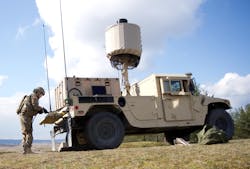SRCTec to build exportable counter-fire radar to defend against rocket, artillery, and mortar (RAM) attacks
ABERDEEN PROVING GROUND, Md. – U.S. Army air-defense experts are asking SRCTec LLC in Syracuse, N.Y., for exportable lightweight counter-fire radar (LCMR) systems to help defend warfighters from rocket, artillery, and mortar (RAM) attacks.
Officials of the Army Contracting Command at Aberdeen Proving Ground, Md., announced a $100 million five-year order to SRCTec last Thursday to procure AN/TPQ-50 exportable systems, spare parts, and repair parts.
The LCMR family of counter-fire radars from SRCTec provides 360-degree surveillance and 3D rocket, artillery, and mortar location using a non-rotating, electronically steered antenna.
The SRCTec LCMR family consists of the AN/TPQ-49 and AN/TPQ-50. The TPQ-50 is the official Army program of record, while the TPQ-49 is designed for expeditionary forces, company officials say.
The radar systems detect and track several different rounds fired from separate locations, and send early warning messages indicating a round is incoming. The radar also pinpoints the location of the incoming round's launcher for counter-fire from friendly artillery, mortars, or aircraft.
Both systems are designed to cover 360 degrees over a nearly 200-square-mile area. The systems can be adapted to cover narrower sectors at longer ranges, if necessary.
In November 2022 the Army awarded a $12.1 million order to SRCTec to build LCMR systems for Ukraine as part of the Ukraine Security Assistance Initiative.
Planned upgrades for the TPQ-50 radar include modernization efforts for electronic protection and to deal with new and emerging threats. Army officials also are developing an integrated hypervelocity armament system (HAS) for future advanced gun weapon systems, command guided maneuverable projectiles, and tactical sensors.
HAS is to include integrating the TPQ-50 radar into future artillery powder guns firing hypervelocity projectiles, resulting in next-generation, common, low drag, guided cannon artillery projectiles capable of completing several different missions with improved cost effectiveness across different gun systems.
Integrating the TPQ-50 and other fire-control radar systems and sensor arrays is expected to enable closed-loop targeting of moving and relocatable targets beyond the range of conventional artillery.
The LCMR AN/TPQ-50 L-band radar system detects incoming RAM from low-quadrant elevations, and provides a more accurate point of origin calculation from greater distances than its predecessors. The radar has a range of nearly 10 miles, can be transported and operated on a vehicle such as a HMMWV, or rapidly placed in rugged terrain by installing it on a tripod.
The LCMR AN/TPQ-49 radar can be assembled or disassembled by two soldiers in 20 minutes. It mounts on a tripod using lightweight antenna hardware. The relatively small system consumes low prime power, making it suitable for low-profile operation.
On this order SRCTec will do the work at locations to be determined with each order, and should be finished by January 2028. For more information contact SRCTec online at www.srcinc.com/products/radar/aesa50-multi-mission-radar.html, or the Army Contracting Command-Aberdeen at https://acc.army.mil/contractingcenters/acc-apg.
About the Author
John Keller
Editor-in-Chief
John Keller is the Editor-in-Chief, Military & Aerospace Electronics Magazine--provides extensive coverage and analysis of enabling electronics and optoelectronic technologies in military, space and commercial aviation applications. John has been a member of the Military & Aerospace Electronics staff since 1989 and chief editor since 1995.
